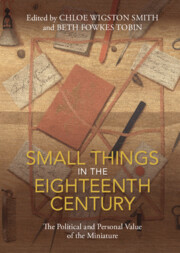Book contents
- Small Things in the Eighteenth Century
- Small Things in the Eighteenth Century
- Copyright page
- Contents
- Figures
- Notes on Contributors
- Acknowledgments
- Introduction
- Part I Reading Small Things
- Part II Small Things in Time and Space
- Part III Small Things at Hand
- Part IV Small Things on the Move
- 14 Hooke’s Ant
- 15 Portable Patriotism
- 16 Revolutionary Histories in Small Things
- 17 A Box of Tea and the British Empire
- Afterword
- Select Bibliography
- Index
14 - Hooke’s Ant
from Part IV - Small Things on the Move
Published online by Cambridge University Press: 29 September 2022
- Small Things in the Eighteenth Century
- Small Things in the Eighteenth Century
- Copyright page
- Contents
- Figures
- Notes on Contributors
- Acknowledgments
- Introduction
- Part I Reading Small Things
- Part II Small Things in Time and Space
- Part III Small Things at Hand
- Part IV Small Things on the Move
- 14 Hooke’s Ant
- 15 Portable Patriotism
- 16 Revolutionary Histories in Small Things
- 17 A Box of Tea and the British Empire
- Afterword
- Select Bibliography
- Index
Summary
The ant in Robert Hooke’s compendium and celebration of microscopy in Micrographia: or Some Physiological Descriptions of Minute Bodies Made by Magnifying Glasses (1665) uniquely resists scientific scrutiny: moving about when alive, too-easily crushed when dead, the ant proves to be insistently difficult to study under a microscope. Through an extended allusion to Richard Ligon’s A True and Exact History of the Island of Barbadoes (1657), Hooke links the unruly ant to the colonial economy of enslaved Africans in Barbados, a place that Ligon understands through sugarcane, enslaved Africans, and saltwater slavery. The story of Hooke’s ant in Micrographia uncovers what Lisa Lowe calls the “intimacy” of modern, Western liberalism and the global conditions upon which it depends. In this case, Hooke’s ant reveals the intimacy of early scientific practice and the institution of transatlantic chattel slavery, exposing in the process that a small thing can reveal vast scales of geography and their networks of exploitation.
Keywords
- Type
- Chapter
- Information
- Small Things in the Eighteenth CenturyThe Political and Personal Value of the Miniature, pp. 225 - 239Publisher: Cambridge University PressPrint publication year: 2022

